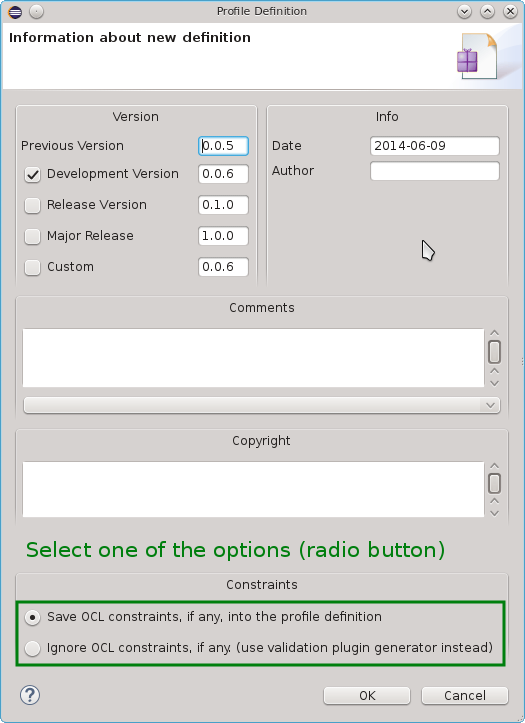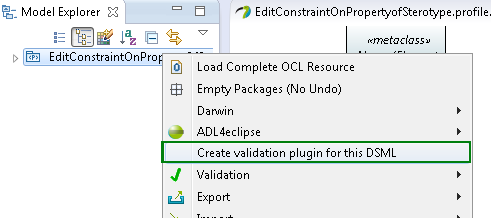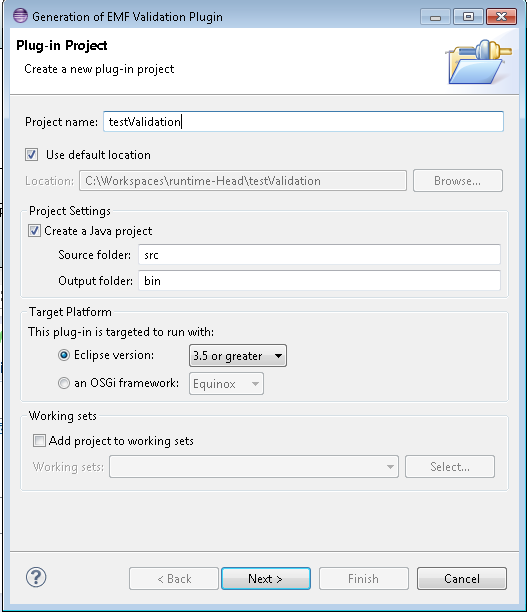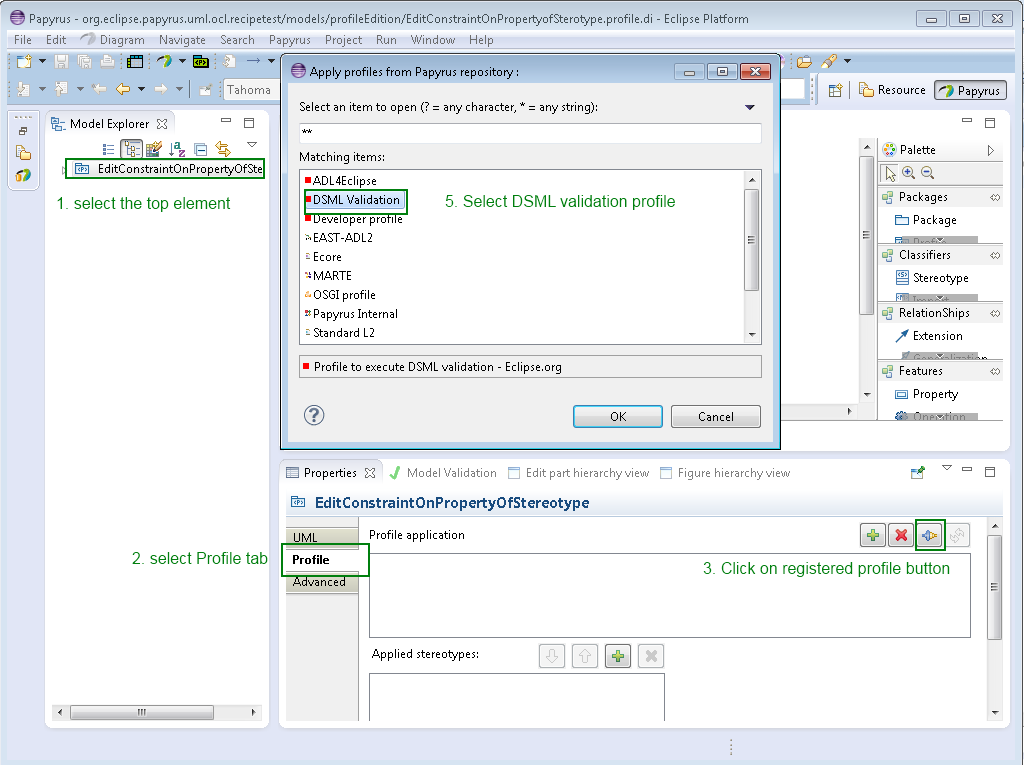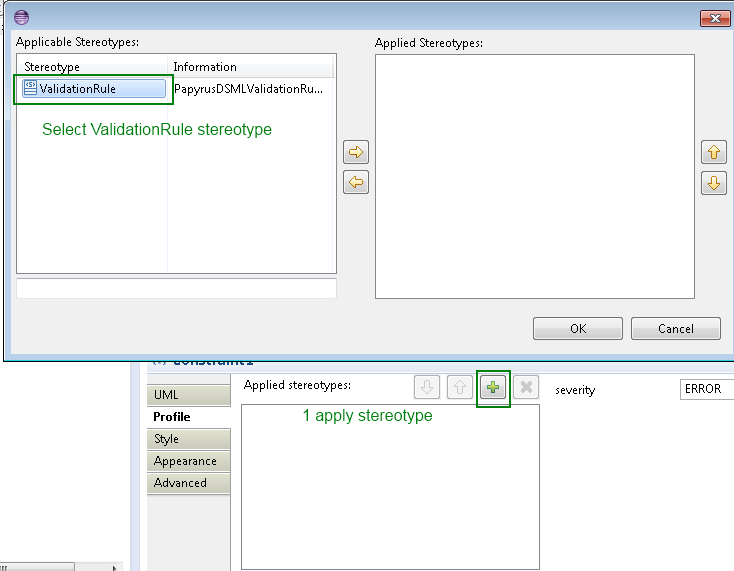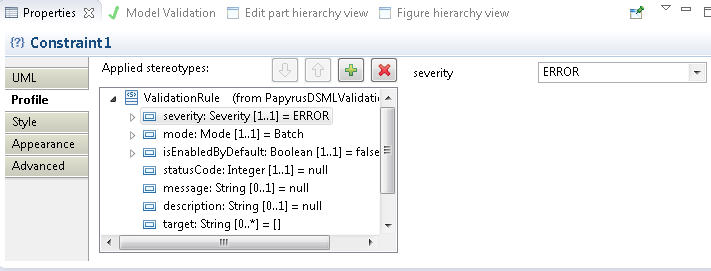Notice: this Wiki will be going read only early in 2024 and edits will no longer be possible. Please see: https://gitlab.eclipse.org/eclipsefdn/helpdesk/-/wikis/Wiki-shutdown-plan for the plan.
Difference between revisions of "Papyrus/UserGuide/Profile Constraints"
m |
m |
||
| Line 3: | Line 3: | ||
Papyrus supports two alternative ways of validating whether constraints are respected by models. Both ways provide the option to augument the information presented to the user when a given constraint fails. The user is always presented with a list of which constraints failed. While this is an important information, it is better to have a customized message describing what is wrong. It's also useful to specify the severity, in particular, whether a constraint violation is an error or warning. | Papyrus supports two alternative ways of validating whether constraints are respected by models. Both ways provide the option to augument the information presented to the user when a given constraint fails. The user is always presented with a list of which constraints failed. While this is an important information, it is better to have a customized message describing what is wrong. It's also useful to specify the severity, in particular, whether a constraint violation is an error or warning. | ||
| − | To augment the default constraint failure information | + | To augment the default constraint failure information you can either generate the constraints directly into the profile definition or generate a plugin that embeds the constraints. Both approaches are described below. |
== Generate constraints directly into the profile definition == | == Generate constraints directly into the profile definition == | ||
| − | Constraints written in OCL within a UML profile can be generated into the definition of the profile. | + | === DSML Profile Augmentation=== |
| + | Constraints written in OCL within a UML profile can be generated into the definition of the profile. The constraint definition is taken into account during the validation of models that have applied the profile. This method is only applicable for OCL constraints. | ||
How to embed the constraints definitions into a UML Profile: | How to embed the constraints definitions into a UML Profile: | ||
| Line 19: | Line 20: | ||
</center> | </center> | ||
| − | === | + | === OCL Pivot Triple Augmentation === (Comment:This is confusing, where do I enter these tupples? This approach is an alternative to the one in the paragraph above but that is not clearly stated.) |
The OCL pivot delegate supports a specific way to encode a customized message and severity in the OCL constraint: The constraint needs to be written in form of a tuple, as shown here for an example. | The OCL pivot delegate supports a specific way to encode a customized message and severity in the OCL constraint: The constraint needs to be written in form of a tuple, as shown here for an example. | ||
| Line 35: | Line 36: | ||
At the moment, there is no specific support in Papyrus to facilitate entering OCL expressions in this way. Since the whole tuple is a "normal" OCL expression, syntax validation and completion is supported by the xtext based expression editor. But it is currently not clear whether Papyrus will offer a way to edit this tuple in a user friendly way, e.g. by synchronizing message and severity with information from the DSML stereotype and only showing the original OCL constraint to the user. | At the moment, there is no specific support in Papyrus to facilitate entering OCL expressions in this way. Since the whole tuple is a "normal" OCL expression, syntax validation and completion is supported by the xtext based expression editor. But it is currently not clear whether Papyrus will offer a way to edit this tuple in a user friendly way, e.g. by synchronizing message and severity with information from the DSML stereotype and only showing the original OCL constraint to the user. | ||
| − | === Summary === | + | === Summary === (Comment:This is confusing, which approach are you summarizing?) |
If you only deal with OCL constraints, this method is simple and straightforward. But it is not possible to select whether constraints defined in this way are included for validation or not (they are always included). | If you only deal with OCL constraints, this method is simple and straightforward. But it is not possible to select whether constraints defined in this way are included for validation or not (they are always included). | ||
| − | |||
== Generate a plugin that embeds the constraints == | == Generate a plugin that embeds the constraints == | ||
| − | + | Users can generate a plugin from a profile that embeds the constraints, which are expressed either in OCL or Java. OCL constraints are embedded into the plugin.xml while Java constraints can directly be compiled into code. This is supported by the EMF validation framework. | |
| − | CAVEAT: The validation of OCL rules within a plugin is a rather old mechanism. It does not take the user preference of an OCL validation delegate into account. Therefore, validation is done with the classical LPG mechanism whereas the constraint editor within Papyrus validates the constraint itself (not whether other parts of the model respect the constraint) using the Pivot OCL mechanism. In particular, the qualified name of UML meta classes in LPG must start with uml:: whereas Pivot requires UML:: (upper case). Papyrus will offer a way to | + | CAVEAT: The validation of OCL rules within a plugin is a rather old mechanism. It does not take the user preference of an OCL validation delegate into account. Therefore, validation is done with the classical LPG mechanism whereas the constraint editor within Papyrus validates the constraint itself (not whether other parts of the model respect the constraint) using the Pivot OCL mechanism. In particular, the qualified name of UML meta classes in LPG must start with uml:: whereas Pivot requires UML:: (upper case). In the future Papyrus will offer a way to ensure that the Pivot will be used for OCL contraints within plugins. |
=== How to embed the generate constraints into a plugin === | === How to embed the generate constraints into a plugin === | ||
| Line 55: | Line 55: | ||
*2. Select the UML Profile element in the Model Explorer | *2. Select the UML Profile element in the Model Explorer | ||
*3. Right click UML Profile element | *3. Right click UML Profile element | ||
| − | *4. Select " | + | *4. Select "Create validation plugin for this DSML" from the context menu |
<center> | <center> | ||
[[image:PapyrusDSML-PluginValidationGeneration.png]]<br/> | [[image:PapyrusDSML-PluginValidationGeneration.png]]<br/> | ||
| Line 61: | Line 61: | ||
</center> | </center> | ||
| − | *5. Choose whether you want to create a new plugin or generate into the plugin | + | *5. Choose whether you want to create a new plugin or generate the code into the plugin containing the profile. The latter is the default. |
<center> | <center> | ||
[[image:PapyrusDSML-GenPluginQuestion.png]]<br> | [[image:PapyrusDSML-GenPluginQuestion.png]]<br> | ||
| Line 93: | Line 93: | ||
* Target: The element to be validated (normally not required since generated context selectors take care of that, see section below) | * Target: The element to be validated (normally not required since generated context selectors take care of that, see section below) | ||
| − | Please note that the additional constraint information | + | Please note that the additional constraint information is only taken in to account if you generate a plugin embedding the constraints into the plugin.xml, as discussed above. |
=== How to apply the DSML validation profile === | === How to apply the DSML validation profile === | ||
| Line 136: | Line 136: | ||
=== Summary === | === Summary === | ||
| − | This method is a bit more complicated than the first, but also more powerful. It works for both OCL and Java. The constraints are grouped in a category that can be included in the validation or not. A message and severity specified via the DSML validation profile is taken into account | + | This method is a bit more complicated than the first, but also more powerful. It works for both OCL and Java. The constraints are grouped in a category that can be included in the validation or not. A message and severity specified via the DSML validation profile is taken into account. It is also possible to distinguish between Live and Batch constraints. Note that this approach is currently of limited use in the case of OCL constraints as different OCL backends are used during constraint definition and validation. |
Revision as of 11:46, 11 June 2014
Contents
Constraint validation
Papyrus supports two alternative ways of validating whether constraints are respected by models. Both ways provide the option to augument the information presented to the user when a given constraint fails. The user is always presented with a list of which constraints failed. While this is an important information, it is better to have a customized message describing what is wrong. It's also useful to specify the severity, in particular, whether a constraint violation is an error or warning.
To augment the default constraint failure information you can either generate the constraints directly into the profile definition or generate a plugin that embeds the constraints. Both approaches are described below.
Generate constraints directly into the profile definition
DSML Profile Augmentation
Constraints written in OCL within a UML profile can be generated into the definition of the profile. The constraint definition is taken into account during the validation of models that have applied the profile. This method is only applicable for OCL constraints.
How to embed the constraints definitions into a UML Profile:
- 1. Save the profile
- 2. Papyrus asks: "Would you like to define it" (the profile), select Yes
- 3. Ensure "Save OCL constraints, if any, into the profile definition" is selected (this is checked by default). Please note that you should not embed constraints into the profile, if you plan to generate a plugin (see next section)
=== OCL Pivot Triple Augmentation === (Comment:This is confusing, where do I enter these tupples? This approach is an alternative to the one in the paragraph above but that is not clearly stated.)
The OCL pivot delegate supports a specific way to encode a customized message and severity in the OCL constraint: The constraint needs to be written in form of a tuple, as shown here for an example.
Tuple{
status=base_Class.isActive,
message='\'' + base_Class.name + '\' is not active',
severity=-5
}.status
The original constraint expression is defined in the status field of the tuple, as well as the message and severity fields. Whereas only the status field is returned during evaluation, OCL evaluation with the Pivot delegate will also evaluate the custom message and severity.
At the moment, there is no specific support in Papyrus to facilitate entering OCL expressions in this way. Since the whole tuple is a "normal" OCL expression, syntax validation and completion is supported by the xtext based expression editor. But it is currently not clear whether Papyrus will offer a way to edit this tuple in a user friendly way, e.g. by synchronizing message and severity with information from the DSML stereotype and only showing the original OCL constraint to the user.
=== Summary === (Comment:This is confusing, which approach are you summarizing?)
If you only deal with OCL constraints, this method is simple and straightforward. But it is not possible to select whether constraints defined in this way are included for validation or not (they are always included).
Generate a plugin that embeds the constraints
Users can generate a plugin from a profile that embeds the constraints, which are expressed either in OCL or Java. OCL constraints are embedded into the plugin.xml while Java constraints can directly be compiled into code. This is supported by the EMF validation framework.
CAVEAT: The validation of OCL rules within a plugin is a rather old mechanism. It does not take the user preference of an OCL validation delegate into account. Therefore, validation is done with the classical LPG mechanism whereas the constraint editor within Papyrus validates the constraint itself (not whether other parts of the model respect the constraint) using the Pivot OCL mechanism. In particular, the qualified name of UML meta classes in LPG must start with uml:: whereas Pivot requires UML:: (upper case). In the future Papyrus will offer a way to ensure that the Pivot will be used for OCL contraints within plugins.
How to embed the generate constraints into a plugin
- 1. Install the DSML validation support from the Papyrus extensions
Help->Install New Software, select Papyrus update site, deselect "group items by category" and search for DSML.
- 2. Select the UML Profile element in the Model Explorer
- 3. Right click UML Profile element
- 4. Select "Create validation plugin for this DSML" from the context menu
- 5. Choose whether you want to create a new plugin or generate the code into the plugin containing the profile. The latter is the default.
- 6. [Only in case of new plugin]: Enter a Project name when prompted by the wizard, complete the wizard and select Finish
- 7. Install or deploy the plugin with associated profile
Refine constraint validation
Papyrus supports a UML profile that enables a developer to refine how constraints are violated. This profile is called Domain Specific Modeling Language (DSML), since it is often used in the context of profiles that adds domain specific concepts to UML.
The additional profile enables a specification of the following properties:
- Mode: Defines if the validation of the constraint is done in “batch” or “live” mode
- Severity: Defines the severity of the constraint violation. It can be one of INFORMATION, WARNING or ERROR. The latter is the default severity (if none is specified). The CANCEL severity should be used with caution, as it causes the validation operation to be interrupted, possibly resulting in the loss of valuable diagnostic information from other constraints.
- Message: Defines the message that will be displayed if the constraint is violated
- Description: Provides a description of the constraint
- Enabled by default: Defined if this constraint should be enabled by default or not
The attributes of the profile correspond quite closely to the possibilities that the EMF validation framework offers when constraints are specified in the plugin.xml of a profile.
Advanced users can also define:
- Status code: The plug-in unique status code, useful for logging.
- Target: The element to be validated (normally not required since generated context selectors take care of that, see section below)
Please note that the additional constraint information is only taken in to account if you generate a plugin embedding the constraints into the plugin.xml, as discussed above.
How to apply the DSML validation profile
- 1. Install the DSML profile from the Papyrus extensions
Help->Install New Software, select Papyrus update site, deselect "group items by category" and search for DSML
- 2. Select the UML Profile element in the Model Explorer
- 3. Select the Profile tab in the Properties View
- 4. Click on the "Apply registered profile" button
- 5. Select the "DSML Validation" profile
- 5. Select the UML Constraint element in the Model Explorer or diagram
- 6. Select the Profile tab of the Properties View
- 7. Click on the "Apply stereotype" button
- 8. Select the ValidationRule stereotype
- 9. Edit the stereotype properties to define information about the behavior of the validation
Summary
This method is a bit more complicated than the first, but also more powerful. It works for both OCL and Java. The constraints are grouped in a category that can be included in the validation or not. A message and severity specified via the DSML validation profile is taken into account. It is also possible to distinguish between Live and Batch constraints. Note that this approach is currently of limited use in the case of OCL constraints as different OCL backends are used during constraint definition and validation.
Information about generated code
This section contains information about the code in the generated plugin. It is intended for readers that want to understand how the generated plugin works.
The EMF validation framework supports constraints by means of a suitable definition in the plugin.xml file that embeds OCL or Java constraints, as shown here (example taken from the OCL tutorial).
First define a category
<extension point="org.eclipse.emf.validation.constraintProviders">
<category
name="Your category" id="emf-validation-example/ocl">
Category description
</category>
Then define constraints within the category
<constraint lang="OCL" severity="WARNING" mode="Batch" name="An example" id="example1" statusCode="101">
<description>Describe it</description>
<message>Write the message</message>
<target class="Writer"/>
<![CDATA[
self.books->collect(b : Book | b.category)->asSet()->size() <= 2
]]>
</constraint>
Constraint validation needs to be done on the context element. Therefore, the plug-in definition needs to associate constraints with the elements that should be validated. This is called constraint binding. The following snipped shows an example of such a binding.
<extension point="org.eclipse.emf.validation.constraintBindings">
<clientContext id="MyContextID">
<selector class=myplugin.selectors.ConstraintSelector"/>
</clientContext>
<binding context="MyContextID">
<constraint ref="myplugin.example1"/>
</binding>
The generator creates a selector for each context element (typically a stereotype). The selector checks the element to be validated and selects those typed with the context element or a sub-types thereof. The constraint binding associates a list of constraints with the selector: those that share the same context element.

